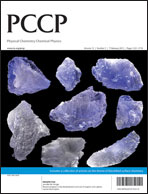This article focuses on thermally induced methanol reactions on bimetallic Ru(0001)-based catalyst surfaces performed under ultrahigh vacuum conditions. Specifically, reaction intermediates and pathways on various clean and oxygen covered surfaces (Ru(0001), Cu/Ru(0001), Pt/Ru(0001), and PtxRu1−x/Ru(0001) surface alloys) have been studied by means of Fourier transform infrared spectroscopy and temperature programmed desorption. On the basis of our results and results reported in the literature methanol reactions on metal surfaces can be subdivided into two major pathways: (i) total dehydrogenation of methanol leading to CO, and (ii) an oxidation pathway which produces gaseous CO2. On the clean surfaces either the dehydrogenation pathway is observed or no reaction occurs at all. The CO2 producing path opens up only upon adsorption of oxygen. In parallel, the CO formation diminishes. In this context, the influence of oxygen on the yields of possible reaction products is analyzed. Generally, it is found that methanol reactions are promoted by disordered and dilute oxygen layers; dense and ordered O-overlayers, on the other hand, passivate the surface effectively. Referring to the direct methanol fuel cell (DMFC), a significant drawback of adding oxygen is the reaction of the oxygen atoms with hydrogen from methanol dehydrogenation to gaseous water. As hydrogen is the energy provider in a DMFC the desorbing water represents an unwanted drain of H atoms. Interestingly, the surfaces which produce the highest amount of CO2 are also most efficient with respect to water formation. As the drain of H atoms on oxygen covered PtxRu1−x/Ru(0001) surface alloys is limited and they nonetheless exhibit CO2 as a final product they represent a compromise regarding the ideal catalyst material for a DMFC. In particular, alloys with a Pt content of 50−80% are found to display superior performance.

You have access to this article
 Please wait while we load your content...
Something went wrong. Try again?
Please wait while we load your content...
Something went wrong. Try again?


 Please wait while we load your content...
Please wait while we load your content...